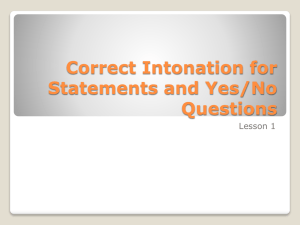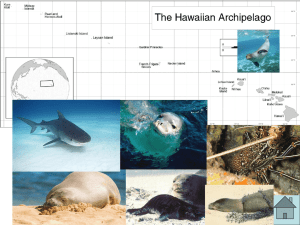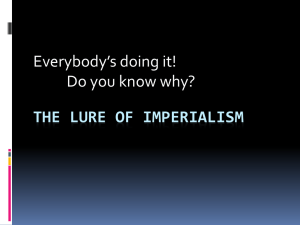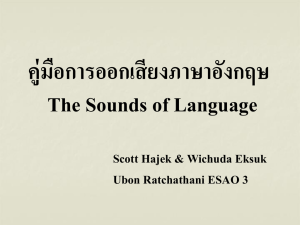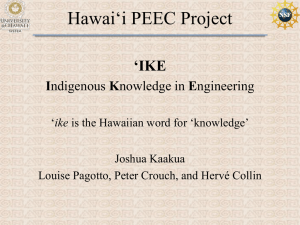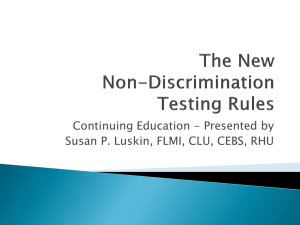Hawaiian Influence on HCE Intonation
advertisement
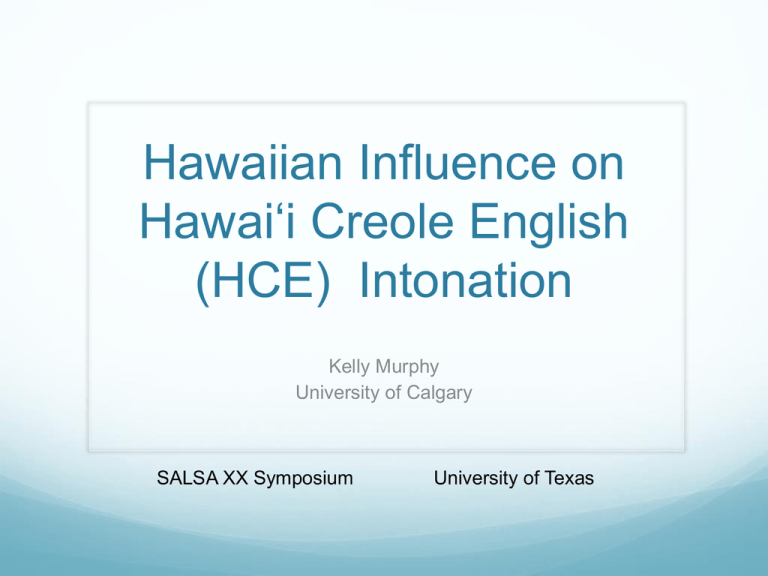
Hawaiian Influence on Hawaiʻi Creole English (HCE) Intonation Kelly Murphy University of Calgary SALSA XX Symposium University of Texas Hawaiian Influence on HCE Intonation Hawaiʻi Creole English (HCE) has a falling Yes/No Question intonation. Many languages in contact in HawaiʻiWhere does HCE get this intonation structure? Timeline 800 AD (or earlier) Hawaiian Islands settled by Native Hawaiians 1778 Captain Cook arrives 1820-1880’s Whaling Era (Roberts, 1998) (Siegel, 2001) Mid 1800’s-1940’s Plantation Labor Languages and Cultures in Contact Hawaiian Portuguese Chinese Japanese English Substrate Influence Hawaiian Imprint Siegel (2001) credits Portuguese and Cantonese as dominating languages during the stabilization of HCE due to large populations at the time. Hawaiian language not credited as a substantial contributor due to decrease in Hawaiian population during stabilization (suggested by Siegel) Speaker Intuition suggesting Pidgin and Hawaiian similar intonation Founder’s Effect “…in terms of lasting impact, activities of a few hundred, or even a few score, initial colonizers can mean much more for the cultural geography of a place than the contributions of tens of thousands of new immigrants a few generations later.” (Zelinsky, 1973) Mufwene (2007) applied same principle to explain creole genesis. Structure predetermined by the characteristics of the founding population. Hawaiian Question Intonation Hawaiian has falling Yes/No Question Intonation Question and statement sentence structure is the same- the intonation is what changes Statement: Kapu kaʻaina ma Kona. The land in Kona is sacred. Question: Kapu kaʻaina ma Kona? Is the land in Kona sacred? Hawaiian Statement Hawaiian Yes/No Question Hawaiian Yes/No Question and Statement Hawaiian Data Sources Clinton Kanahele Collection (BYU) University of Hilo, HAW 101 podcast Youtube videos, Ahonui Mims Learning Hawaiian KSDL Online Hawaiian Lessons HCE Question Intonation Striking Falling Yes/No Question intonation HCE is an English lexified creole, but has retained the imprint of substrate language intonation (Hawaiian) Examples taken from Anykine Kine podcast as well as Youtube videos, interviews HCE Yes/No Question HCE Yes/No Question HCE Yes/No Question HCE Data Sources Anykine Kine Podcast HPU Students Guess Who? Game KSDL Ahonui Mims Living Aloha Spirit Lee Tonouchi, ‘da pidgin guerilla’ Full on Pidgin, archived Youtube videos Comparing Hawaiian, HCE, and English Hawaiian Yes/No Question Starts higher, peaks at the end to emphasize the fall, showing a more dramatic fall HCE Yes/No Question Starts higher, peaks at the end to emphasize the fall, showing a more dramatic fall Yes/No? Wh-? Tag Echo Hawaiian Falling Falling Rise/Fall Fall HCE Falling Falling Rise/Fall Fall English Rising Falling Rise Rise Why Hawaiian? Why Hawaiian and not: Portuguese? Rising Intonation in Yes/No Questions (Vigario and Frota, 2003 ) Chinese? Tonal Language, global raising and final rise. No terminal fall (Ma, Ciocca, and Whitehill, 2006) English? (Gussenhoven, 2004), no slump exists in English, English Echo questions invariably rise (Hirst, Di Cristo, 1998) Hawaiian Echo questions fall as well as HCE. Implications of Study Substrate Influence because: Universalist theory would predict raising Yes/No Question intonation Hawaiian recognized as substantial contributor to HCE Answer question about HCE intonation that has been implied by speaker intuition Language Identity Provide much needed documentation of Hawaiian and HCE intonation structure Conclusion Hawaiian has influenced HCE with Yes/No Question intonation Future studies Language identity and attitudes Questions? References Anykine Kine. Podcast, San Francisco. 12 February 2006. Retrieved on 23 Mar 2006, Clinton Kanahele Collection, Brigham Young University. Retrieved January 2012. Full on pidgin. (n.d.). Retrieved Mar. 23, 2006, from Full On Pidgin Web site: http://www.extreme-hawaii.com/pidgin/vocab/. Gussenhoven, C. (2004) The Phonology of tone and intonation. Cambridge: Cambridge University Press Hirst, D., Di Cristo, A. (1998) Intonation Systems: A Survey of twenty languages. Cambridge: Cambridge University Press Kulaiwi.(2005) Kamehameha Schools Distance Learning. Online Hawaiian language lessons. Retrieved Mar. 26, 2006, from http://ksdl.ksbe.edu/kulaiwi/. Ma, J. K-Y., Ciocca, V., & Whitehill, T. L. (2006). The effect of intonation on Cantonese lexical tones. Journal of the Acoustical Society of America, 120 (6), 39783987. Mufwene, Salikoko (2007). The ecology of language evolution. Cambridge: Cambridge University Press Roberts, S. J. (1998) The role of diffusion in the genesis of Hawaiian Creole. Language 74 (1) Siegel, J. 2000. Substrate influence in Hawai'i Creole English. Language in Society 29 (2), 197-236. Vigário, Marina & Sónia Frota. 2003. The intonation of Standard and Northern European Portuguese. Journal of Portuguese Linguistics 2-2 (Special Issue on Portuguese Phonology, edited by W. L. Wetzels), 115-137. Zelinsky, W. (1973) The Cultural Geography of the United States. Englewood Cliffs: Prentice-Hall. December 2009, January 2010. http://anykinekine.blogspot.com.


